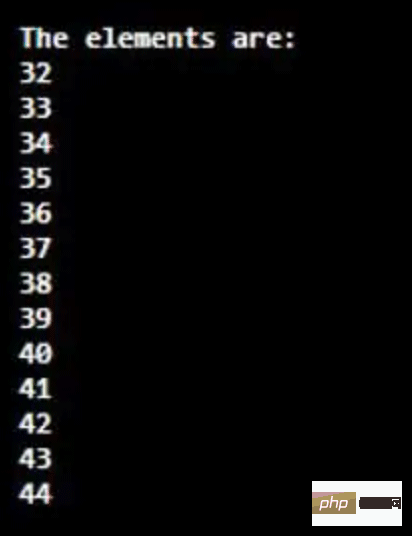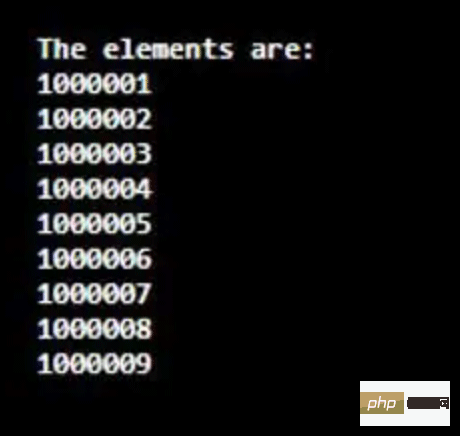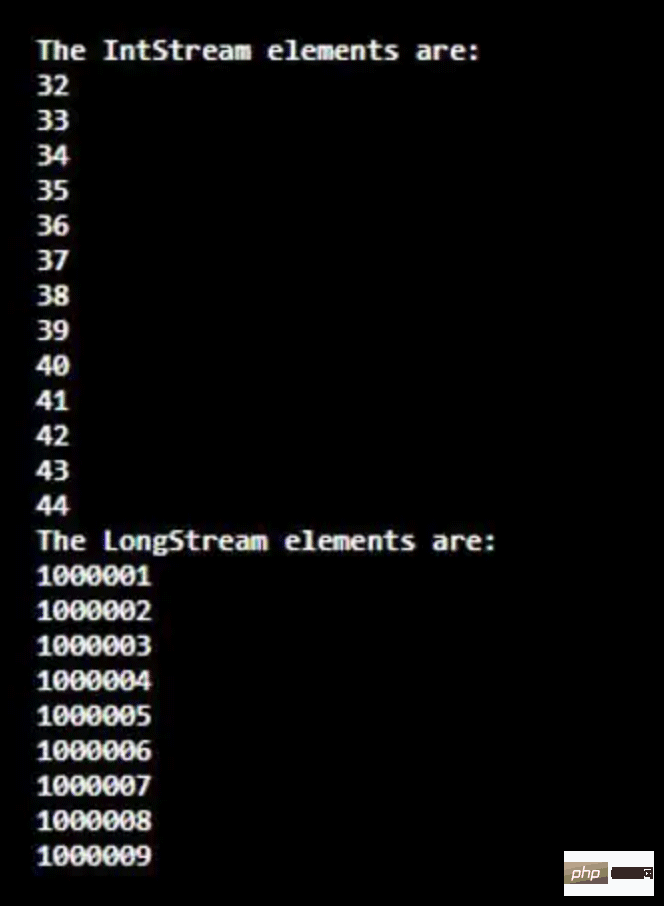前言
在Java中,Range方法在IntStream和LongStream类中都可用。在IntStream类中,它有助于返回函数参数范围内IntStream的顺序值。在该方法中,startInclusive(inclusive)和endExclusive(exclusive)是与增量步长一起使用的两个参数,如前所述,将包括起始值,并排除结束值。在LongStream的情况下,唯一的区别是添加了LongStream值。
Range语法
让我们看看Java中range方法的语法。
IntStream范围的语法
static IntStream range(int startInclusive, int endExclusive)
参数:
IntStream:这是一个原始类型的int值元素序列。
startInclusive:包含在范围中的初始值。
endExclusive:在范围内排除的最后一个值或上限。
返回值:
该方法返回范围中提到的int元素的连续int流作为参数。
LongStream范围的语法
static LongStream range(int startInclusive, int endExclusive)
参数:
LongStream:这是一个基元类型的长值元素序列。
startInclusive:包含在范围中的初始值。
endExclusive:在范围内排除的最后一个值或上限。
返回值:
该方法返回范围中提到的长元素的连续长流作为参数。
Range函数在Java中是如何工作的?
首先,让我们看看IntStream范围在Java中是如何工作的。与Java中的其他类类似,这个类也需要一个必须首先导入的包。也就是说,为了使用IntStream类,导入包java.util.stream.IntStream。导入后,创建一个IntStream,以便可以向其中添加元素。创建流后,使用方法range()添加元素。在执行代码时,将通过在参数中提到的范围内的一个增量步骤返回一个序列有序IntStream。
要打印每个元素,请使用如下所示的方法。
intStream.forEach(System.out::println);
对于LongStream,首先导入包java.util.stream.LongStream。与IntStream的功能类似,一旦导入包,就创建一个LongStream,以便可以向其中添加元素。创建流后,使用方法range()添加元素。在执行代码时,将通过在参数中提到的范围内的一个增量步骤返回序列有序的长流。
用于使用如下所示的方法打印每个元素。
LongStream.forEach(System.out::println);
在for循环的帮助下,可以按顺序生成递增元素的等效打印序列,
如下所示:
for (inti = startInclusive; i<endExclusive ; i++)
{... . . . }Java中的Range示例
以下是提到的示例:
示例#1
Java程序实现IntStream Range函数。
代码:
// IntStream range implementation using Java
import java.util.*;
//import the package for IntStream
import java.util.stream.IntStream;
public class RangeExample {
// main method
public static void main(String[] args)
{
// Create an IntStream
IntStream st = IntStream.range(32, 45);
// Display the elements in the range mentioned as 32 and 45 where 32 is included and 45 is excluded
System.out.println("The elements are:");
st.forEach(System.out::println);
} }输出:

首先,导入包java.util.stream.IntStream。然后,创建一个IntStream st,用于向其中添加元素。在创建流的过程中,使用方法range(32,45)添加元素,其中包括32个元素,排除45个元素。在执行代码时,将通过一个增量步骤从32到44返回一个有序的IntStream,如示例输出中所示。
示例#2
Java程序实现LongStream range范围函数。
代码:
// LongStream range implementation using Java
import java.util.*;
//import the package for LongStream
import java.util.stream.LongStream;
public class RangeExample {
// main method
public static void main(String[] args)
{
// Create a LongStream
LongStream st = LongStream.range(1000001L, 1000010L);
// Display the elements in the range mentioned as 1000001L and 1000010L where 1000001L is included and 1000010L is excluded
System.out.println("The elements are:");
st.forEach(System.out::println);
} }输出:

与上述程序类似,导入包java.util.stream.LongStream。然后,创建一个具有方法range(100001L、100010L)的LongStreamst,用于向其添加元素。在执行代码时,将通过一个增量步骤从100001L返回到100010L,如示例输出所示。
示例#3
Java程序,用于组合实现LongStream和IntStream range范围函数。
代码:
import java.util.*;
//import the package for IntStream
import java.util.stream.IntStream;
//import the package for LongStream
import java.util.stream.LongStream;
public class RangeExample {
// main method
public static void main(String[] args)
{
// Create an IntStream
IntStream str = IntStream.range(32, 45);
// Display the elements in the range mentioned as 32 and 45 where 32 is included and 45 is excluded
System.out.println("The IntStream elements are:");
str.forEach(System.out::println);
// Create a LongStream
LongStream st = LongStream.range(1000001L, 1000010L);
// Display the elements in the range mentioned as 1000001L and 1000010L where 1000001L is included and 1000010L is excluded
System.out.println("The LongStream elements are:");
st.forEach(System.out::println);
} }输出:

导入包java.util.stream.IntStream 和 java.util.stream.LongStream。然后,创建IntStreamstr和LongStreamst以向其中添加元素。在创建流期间,使用方法range(32,45)在IntStream中添加元素,其中包括32,排除45。同样,使用方法range(100001L、100010L)在LongStream中添加元素。在执行代码时,序列有序IntStream将从32返回到44,LongStream将通过增量步骤1从100001L返回到100010L。
以上是Java中Range函数怎么使用的详细内容。更多信息请关注PHP中文网其他相关文章!
 IntelliJ IDEA是如何在不输出日志的情况下识别Spring Boot项目的端口号的?Apr 19, 2025 pm 11:45 PM
IntelliJ IDEA是如何在不输出日志的情况下识别Spring Boot项目的端口号的?Apr 19, 2025 pm 11:45 PM在使用IntelliJIDEAUltimate版本启动Spring...
 如何优雅地获取实体类变量名构建数据库查询条件?Apr 19, 2025 pm 11:42 PM
如何优雅地获取实体类变量名构建数据库查询条件?Apr 19, 2025 pm 11:42 PM在使用MyBatis-Plus或其他ORM框架进行数据库操作时,经常需要根据实体类的属性名构造查询条件。如果每次都手动...
 如何利用Redis缓存方案高效实现产品排行榜列表的需求?Apr 19, 2025 pm 11:36 PM
如何利用Redis缓存方案高效实现产品排行榜列表的需求?Apr 19, 2025 pm 11:36 PMRedis缓存方案如何实现产品排行榜列表的需求?在开发过程中,我们常常需要处理排行榜的需求,例如展示一个�...
 如何将姓名转换为数字以实现排序并保持群组中的一致性?Apr 19, 2025 pm 11:30 PM
如何将姓名转换为数字以实现排序并保持群组中的一致性?Apr 19, 2025 pm 11:30 PM将姓名转换为数字以实现排序的解决方案在许多应用场景中,用户可能需要在群组中进行排序,尤其是在一个用...
 电商平台SKU和SPU数据库设计:如何兼顾用户自定义属性和无属性商品?Apr 19, 2025 pm 11:27 PM
电商平台SKU和SPU数据库设计:如何兼顾用户自定义属性和无属性商品?Apr 19, 2025 pm 11:27 PM电商平台SKU和SPU表设计详解本文将探讨电商平台中SKU和SPU的数据库设计问题,特别是如何处理用户自定义销售属...
 在Idea中如何设置SpringBoot项目默认运行配置列表以便团队成员共享?Apr 19, 2025 pm 11:24 PM
在Idea中如何设置SpringBoot项目默认运行配置列表以便团队成员共享?Apr 19, 2025 pm 11:24 PM在Idea中如何设置SpringBoot项目默认运行配置列表在使用IntelliJ...


热AI工具

Undresser.AI Undress
人工智能驱动的应用程序,用于创建逼真的裸体照片

AI Clothes Remover
用于从照片中去除衣服的在线人工智能工具。

Undress AI Tool
免费脱衣服图片

Clothoff.io
AI脱衣机

Video Face Swap
使用我们完全免费的人工智能换脸工具轻松在任何视频中换脸!

热门文章

热工具

EditPlus 中文破解版
体积小,语法高亮,不支持代码提示功能

PhpStorm Mac 版本
最新(2018.2.1 )专业的PHP集成开发工具

禅工作室 13.0.1
功能强大的PHP集成开发环境

WebStorm Mac版
好用的JavaScript开发工具

螳螂BT
Mantis是一个易于部署的基于Web的缺陷跟踪工具,用于帮助产品缺陷跟踪。它需要PHP、MySQL和一个Web服务器。请查看我们的演示和托管服务。








